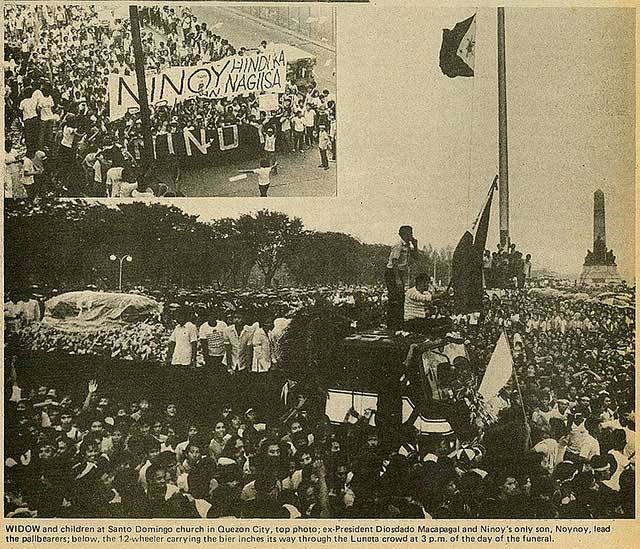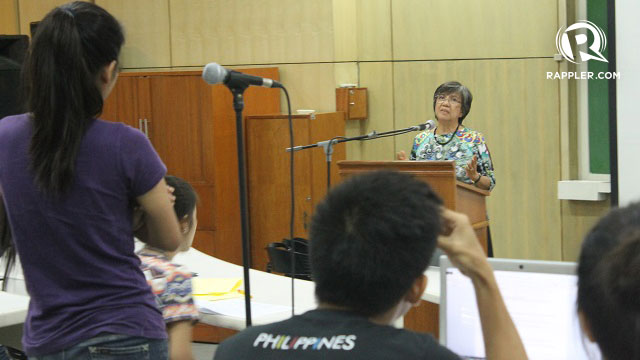SUMMARY
This is AI generated summarization, which may have errors. For context, always refer to the full article.

MANILA, Philippines – Benigno “Ninoy” Aquino Jr’s funeral procession lasted about 12 hours, and over a million graced the streets until Aquino’s body was buried at the Manila Memorial Park on Aug 31, 1983.
But a newspaper’s headline the next day was not about the million who marched, or about the protests of discontent. It was about a man struck by lightning when he sat on the branch of a tree to get a view of the procession.
“The people were in the news, but the news did not report their presence. This was the turning point,” journalist Melinda Quintos de Jesus said during her lecture entitled, “The Aquino Assassination: The Challenge to Media” on Tuesday, September 3.
De Jesus, who was then writing for alternative press Veritas, said it was at this point when the audience realized “how much they could be lied to.”
The gravity dawned on them, although government control on media is something they already knew beforehand.
READ: ‘Ninoy linked up with the Left to aid presidential ambition’
‘Imelda, in flattering angles’
There was silence in both radio and television after Sept 23, 1972, when Ferdinand Marcos declared Martial Law. Editors and journalists were “selectively picked up” and detained along with other political prisoners.
Those who were not detained were not any luckier. The conditions under the authoritarian rule forced them to either change careers, join the underground movement, or leave the country.
“The architects of Martial Law knew that their success depended on silencing the press,” De Jesus noted.
Still worse, there were journalists who had to work “under the new rules of the game.”
For non-members of Marcos’ crony press, De Jesus said to play along meant to self-regulate, to avoid writing negative news about the government, and to photograph the first lady in nothing less than the most flattering angles.

One advocacy
For a while, the regime received approval from both the local and international press. But it was only a temporary sentiment; in time, the internal weaknesses in the Marcos government and his health condition resulted in negative stories in the international media.
Meanwhile, the local media began testing the limits of censorship.
But what really pushed the alternative press to go all out on the Marcos’ government was Aquino’s assassination on Aug 21, 1983.
“We had an advocacy bigger than our careers, bigger than our newspapers: we wanted this man out,” De Jesus said. “Therefore, we wanted to be able to work together. It was very friendly at that time. It was a great period because journalists helped each other.”
Citizens also joined the alternative press in their advocacy, and through “xerox journalism” (news clippings written by Filipinos working for foreign news services) passed around information about the plans of the Aquino family.
It became a collaboration between the audience “hungry for news” and the alternative press “[taking the] lead in a period of crisis.”
READ: Ninoy and People Power: Stories of generations
‘Most exciting journalism’
“The fluidity of the situation made it the most exciting journalism it can ever be,” De Jesus said.
Although she said Martial Law disrupted the media development in the country, she admitted the atmosphere of the time led to a kind of journalism “not tempted to go the path of the scoop.”
“In the 3 years framed by the two events (Ninoy’s assassination and EDSA I), alternative press succeeded to galvanize the political will, to erode the ruling power, enliven citizen awareness of the role in the struggle for freedom and…to dialogue and debate a national community committed to restore democracy for the good of the many,” she said.
This brand of journalism provided perspective, analysis, context, and commentary — in short, news that counts. – Rappler.com
“The Aquino Assassination: Thirty Years After” lecture series at the Ateneo de Manila University runs until Sept 17, 2013.
Add a comment
How does this make you feel?
There are no comments yet. Add your comment to start the conversation.